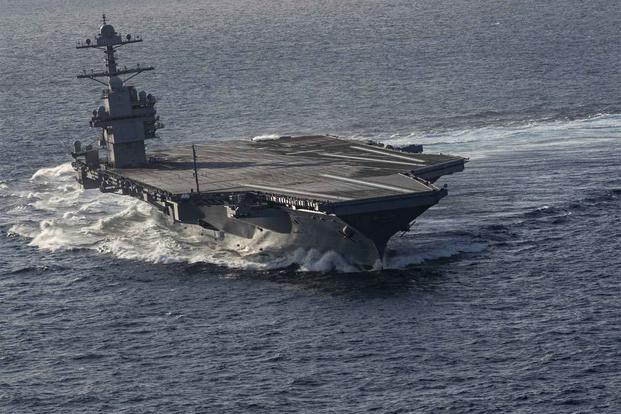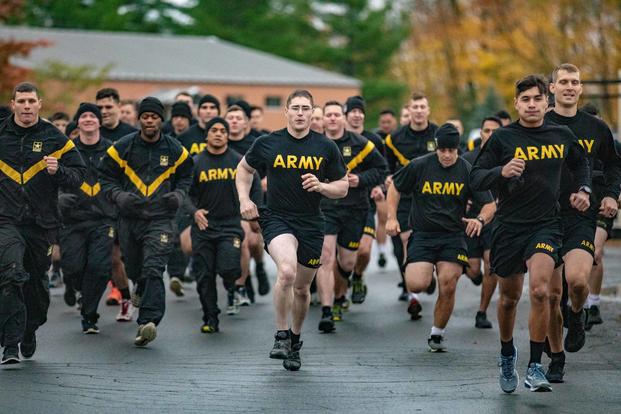In a year that began with the stunning departure of Defense Secretary Jim Mattis from the Pentagon, it's perhaps unsurprising that the dominant themes have been turnover and conflict -- internal as well as external.
Hopes of extricating the U.S. from current conflicts went unfulfilled in 2019: a trumpeted "historic" deal with the Taliban fell apart; a highly controversial withdrawal of U.S. troops from northern Syria nonetheless left many embroiled in the now five-year-old fight against ISIS extremists. Meanwhile, amid provocative action from Iran, a new deployment to Saudi Arabia began.
Inside the Pentagon, nearly every major position saw turnover, much of it unexpected. The building cycled through three acting defense secretaries since Mattis' departure, and the Navy in particular saw some stunning leadership transitions.
Here are the ten top military stories of the chaotic year 2019.

1. Pentagon Power Shifts
After Jim Mattis vacated his post, acting Defense Secretary Patrick Shanahan was heir apparent. He continued on as an acting leader for months and then -- in a stunning development -- abruptly stepped down in June amid new reports of domestic troubles and an FBI investigation. Army Secretary Mark Esper and Navy Secretary Richard Spencer both briefly kept the seat warm until Esper was confirmed as 27th SecDef in July.
While the Pentagon saw a fair amount of normal turnover, with a new Joint Chiefs chairman, Marine Corps commandant and Army secretary, other moves were decidedly off-script. Air Force Secretary Heather Wilson vacated her post for a prestige position in academia; Adm. Bill Moran, President Donald Trump's pick for Chief of Naval Operations, bowed out of consideration suddenly when correspondence with an out-of-favor former officer came to light.
In the final shocker of the year, Esper asked Spencer to resign in November, accusing him of offering a deal to the White House without the Pentagon's knowledge.

2. Debut Deployment
Amid increased mischief from Iran this year, including apparent Iranian attacks on commercial vessels in and around the Persian Gulf, the Pentagon announced a new deployment of troops to Saudi Arabia and the United Arab Emirates to shore up security in the region, alongside Patriot missile batteries.
A month after the initial deployment was announced, officials said even more troops were headed to the region and to the newly reopened Prince Sultan Air Base. The U.S. has yet to answer the June shoot-down of a costly Navy RQ-4 drone by Iranian forces with direct military force, but it's possible Iranian forces have lost some of their boldness since U.S. troops arrived in the region.

3. Carrier Consternation
The Navy's newest and most advanced aircraft carrier, the Gerald R. Ford, still does not have all its weapons elevators working. That's despite Spencer, the Navy secretary, staking his job on the matter earlier this year.
Ultimately, Spencer would be ousted for other reasons; but the $12 billion carrier that is still missing components continues to haunt the Navy. As Trump keeps close tabs on the program, acting Navy Secretary Thomas Modly has said getting the Ford in full working order is now one of the service's top priorities.

4. Space Force Takes Shape
Long-awaited details about the military's planned 6th branch were revealed with the release of the fiscal 2020 defense budget in December. The service will have modest beginnings, staffed by reassigned Air Force personnel and falling under the Air Force leadership structure. But at least one key lawmaker says he's "glowing" about how U.S. Space Force will set the Defense Department up for success in the final frontier. As a precursor to the service's creation, U.S. Space Command uncased its colors at the White House earlier this year and its first four-star commander, Gen. John "Jay" Raymond, took the helm.
Expect more Space Force revelations in 2020, including, perhaps, long-awaited details about the service's planned uniforms and rank structure. Meanwhile, some are most excited about a coming Netflix show starring Steve Carell that imagines what operations in Space Force could look like.

5. ACFT Approaches
Soldiers now have less than a year to get ready for the Army's combat fitness test, a gender- and age-blind functional assessment designed to ensure troops are capable of doing their physically demanding jobs.
Many have called it significantly harder than the current Army physical fitness test -- and the level of difficulty has raised concerns that some, such as those in the Reserve, won't be able to make standards in time. Others worry it could result in career disadvantages for women.
Army officials have continued to modify standards and develop options in a year-long evaluation phase. But despite the difficulty, a few soldiers have already aced the ACFT, proving the feat is not impossible.

6. Racial Rumblings
This year the military found it was not immune from the racial tensions and new current of extremism ripping through the country. A Coast Guard officer based in Washington, D.C. was arrested on suspicion of a terror plot, while separate investigations probed evidence of extremist and white nationalist networks with members in the Air Force, Marine Corps and elsewhere. As the military struggles to identify those with extremist viewpoints before they join the military, Congress is calling for better oversight and reporting of these trends.
The year concluded with another racially tinged scandal when cadets and midshipmen appeared to throw up "white power" hand signals on camera. Others, though, said the outrage was misplaced and the signal had nothing to do with race.

7. Suicide Shock
For active-duty troops and veterans, the year saw troubling trends and sobering new revelations regarding suicide. New data showed military suicides reaching record highs, even as combat deployment rates have declined. And in a horrific new pattern, veterans began to end their lives in the parking lots of Department of Veterans Affairs facilities -- a development VA officials struggled to address and curb. Congress and the VA debated over a provision aimed at getting more resources to suicidal veterans. And a young sailor's family came forward to tell his heartbreaking story of suicide, and all the warning signs that led up to it.

8. Turkey Trouble
One of the United States' most complicated allies presented a series of problems for the military in 2019. Turkey, a NATO member that hosts a crucial U.S. military hub, alarmed its allies when it moved forward with plans to purchase the Russian-made S-400 anti-aircraft weapons system, despite having already made a deal to buy the U.S.-made F-35 Joint Strike Fighter.
Ultimately, Turkey was barred from getting its F-35s, which creates new challenges for the Pentagon, and uneasiness continues within the alliance. In another seismic move, Trump announced that he would pull back troops from northern Syria, paving the way for Turkey to invade the region and target the Kurdish Syrian Democratic Forces who have been U.S. allies on the ground.
The move prompted outcry from many, including troops who had fought in Syria and believed they were abandoning their allies. Ultimately, top military officials confirmed that a small contingent of U.S. forces would remain in Syria to prevent the resurgence of ISIS in the region.

9. Presidential Pardons
Trump sent a shockwave through the military justice system in November when he dispensed pardons to two soldiers in separate military war crimes cases and restored the rank of a Navy SEAL who had been demoted after being found guilty of taking inappropriate war zone photos with a corpse.
While some hailed the president as a defender of maligned American heroes, others -- including a number of military attorneys -- cited concern about what impact his intervention might have in future war crimes cases. Drama continued in the case of SEAL Eddie Gallagher, who faced a review board that could strip him of his prized trident pin.
Trump threatened to intervene and Esper, the defense secretary, ultimately called off the board -- but not before the secretary of the Navy lost his job over the matter.

10. Commissary Confusion
New legislation is about to allow what could be millions more shoppers to take advantage of discounted goods at base commissaries and exchanges. But how exactly will this newly eligible crowd get on base?
As details emerged, it became apparent that delays will face many prospective customers who do not already have proper credentials. As the Jan. 1 legislative deadline to expand commissary and exchange access approaches, officials continue to work out the challenge of base access.
-- Hope Hodge Seck can be reached at hope.seck@military.com. Follow her on Twitter at @HopeSeck.














